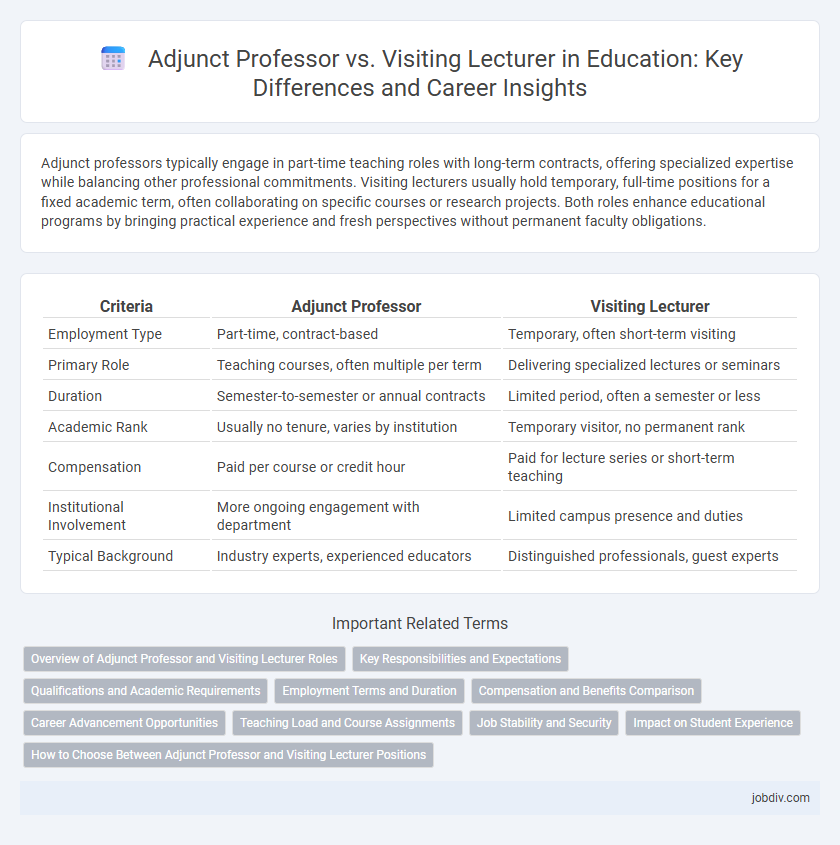Adjunct professors typically engage in part-time teaching roles with long-term contracts, offering specialized expertise while balancing other professional commitments. Visiting lecturers usually hold temporary, full-time positions for a fixed academic term, often collaborating on specific courses or research projects. Both roles enhance educational programs by bringing practical experience and fresh perspectives without permanent faculty obligations.
Table of Comparison
| Criteria | Adjunct Professor | Visiting Lecturer |
|---|---|---|
| Employment Type | Part-time, contract-based | Temporary, often short-term visiting |
| Primary Role | Teaching courses, often multiple per term | Delivering specialized lectures or seminars |
| Duration | Semester-to-semester or annual contracts | Limited period, often a semester or less |
| Academic Rank | Usually no tenure, varies by institution | Temporary visitor, no permanent rank |
| Compensation | Paid per course or credit hour | Paid for lecture series or short-term teaching |
| Institutional Involvement | More ongoing engagement with department | Limited campus presence and duties |
| Typical Background | Industry experts, experienced educators | Distinguished professionals, guest experts |
Overview of Adjunct Professor and Visiting Lecturer Roles
Adjunct Professors typically hold part-time positions, bringing specialized expertise and often balancing teaching with external professional roles, while Visiting Lecturers are usually temporary appointments focused on delivering specific courses or research projects. Both roles enhance academic programs by offering diverse perspectives and flexible staffing options, yet Adjunct Professors often have longer-term commitments compared to Visiting Lecturers. Understanding these distinctions is essential for institutions aiming to optimize faculty resources and academic offerings.
Key Responsibilities and Expectations
Adjunct Professors primarily deliver specialized course instruction and manage student assessments while often maintaining external professional careers relevant to their academic field. Visiting Lecturers focus on temporary teaching assignments, contributing expertise for specific courses or seminars, and are expected to integrate quickly into institutional teaching frameworks. Both roles require adaptability and effective communication, but Adjunct Professors typically have longer-term commitments with greater involvement in curriculum development.
Qualifications and Academic Requirements
Adjunct Professors typically hold a doctoral degree and possess extensive professional or academic experience in their field, meeting rigorous institutional standards for teaching at the graduate or undergraduate level. Visiting Lecturers often have a master's degree or equivalent expertise and are appointed for short-term or specialized teaching assignments, sometimes prioritizing practical skills over research credentials. Both roles require demonstrated subject matter expertise, but Adjunct Professors are generally required to have a stronger academic research background and sustained qualifications.
Employment Terms and Duration
Adjunct Professors typically hold part-time, contract-based positions with flexible employment terms, often hired on a semester-by-semester basis to teach specific courses. Visiting Lecturers usually have fixed-term contracts ranging from one semester to a full academic year, sometimes with the possibility of renewal, and often bring specialized expertise or temporary faculty support. Employment duration for Adjunct Professors tends to be less predictable and more variable compared to Visiting Lecturers, whose appointments generally align with defined academic calendars.
Compensation and Benefits Comparison
Adjunct Professors typically receive compensation on a per-course basis, often without access to full benefits such as health insurance or retirement plans, resulting in lower overall financial security. Visiting Lecturers may receive higher pay rates with some institutions offering partial benefits, reflecting their temporary but more integrated roles within the faculty. Both positions usually lack the comprehensive benefits and job stability found in tenure-track positions, creating distinct financial considerations for professionals in academia.
Career Advancement Opportunities
Adjunct Professors often face limited career advancement opportunities due to their part-time, contract-based roles that typically lack tenure-track benefits and institutional support. Visiting Lecturers, while also usually temporary, may benefit from affiliations with prestigious universities that can enhance their academic profiles and open doors to full-time positions or research collaborations. Understanding these distinctions helps educators strategically target roles aligned with long-term career goals in higher education.
Teaching Load and Course Assignments
Adjunct Professors typically handle a heavier teaching load, often instructing multiple courses per semester, reflecting their role as part-time faculty with ongoing commitments. Visiting Lecturers usually teach fewer courses, frequently a single course or specialized seminar, because their appointments are temporary and geared towards specific expertise. Course assignments for adjuncts emphasize regular teaching duties, whereas visiting lecturers often focus on unique or advanced subjects aligned with their professional background.
Job Stability and Security
Adjunct Professors typically face less job stability and security due to contract-based, often part-time positions with limited benefits. Visiting Lecturers usually have fixed-term appointments that may offer slightly more stability but still lack the long-term security of tenured roles. Both positions generally do not provide the same institutional protections or career advancement opportunities as full-time faculty.
Impact on Student Experience
Adjunct professors often bring real-world industry experience to the classroom, enhancing student engagement through practical insights and applied knowledge. Visiting lecturers typically introduce specialized, cutting-edge topics or research expertise, enriching the curriculum with diverse perspectives that broaden students' academic horizons. Both roles contribute uniquely to student learning, with adjuncts fostering professional readiness and visiting lecturers expanding intellectual depth.
How to Choose Between Adjunct Professor and Visiting Lecturer Positions
Choosing between adjunct professor and visiting lecturer positions depends on career goals, job stability, and teaching responsibilities. Adjunct professors often engage in part-time, contract-based teaching with opportunities for long-term association and benefits, whereas visiting lecturers typically hold temporary, full-time roles focused on specialized courses or research collaboration. Assessing factors such as contract duration, workload, institutional affiliation, and professional development opportunities helps determine the best fit for academic and career advancement.
Adjunct Professor vs Visiting Lecturer Infographic

 jobdiv.com
jobdiv.com